- Submissions

Full Text
Trends in Textile Engineering & Fashion Technology
From Landscape Painting to Fashion Design: A Case Study of the “Wearing Landscape” Design Project
Chien-Chih Ni1 and Rungtai Lin2
1Department of Fashion Design, Hsuan Chuang University, Taiwan
2Graduate School of Creative Industry Design, National Taiwan University of Arts, Taiwan
*Corresponding author:Rungtai Lin, Graduate School of Creative Industry Design, National Taiwan University of Arts, No. 59, Section 1, Daguan Road, Banqiao District, New Taipei City, Taiwan
Submission: August 01, 2022; Published: August 11, 2022

ISSN 2578-0271 Volume 7 Issue1
Abstract
Fashion designers use artists’ paintings on fabrics and fashion design to make clothing walking arts. In the “Wearing Landscape” Exhibition held in 2018, researchers converted two landscape paintings into print fabrics and six sets of clothing through creative hermeneutics to investigate the feasibility of applying artworks to design. In this study, the design program applying landscape painting to fashion design was developed based on Charles Wei-Hsun Fu’s creative hermeneutics. The program analyzed landscape, interpreted landscape, completed landscape paintings, used the paintings to design print fabrics, and designed and made clothing from such fabrics. This study explores how landscape painting is applied to print fabrics and fashion design to form walking arts and, through three print fabrics and six sets of fashion design, investigates the effect of applying paintings to design and proposes suggestions for a feasible model framework for designers between art and design.
Keywords:Landscape painting; Fashion design; Creative hermeneutics
Introduction
Applying artworks to the design of art commodities has become one of the trends of cross-border cooperation between the art and design circles [1]. The combination of art and design is a kind of value exchange because art can stimulate imagination and attract attention [2], while design is an interface that carries artists’ aesthetic beliefs [3]. Artworks are said to be perceived by the public in a more diversified way, with design as the carrier.
Langer SK [4] proposed in Feeling and Form that art is the creation of human emotional symbols from the perspective of symbolic aesthetics; that is, art is a reflection of the essence of human emotions. The emotional form of art is the abstraction of individual-specific emotions that converts ineffable emotions into visible and audible art by means of symbols [4]. People place their emotions on landscapes in a wealth of artworks in both Chinese and Western art history, and these landscape-describing artworks are artists’ interpretations and recordings of landscapes. Although we cannot figure out the views and artists’ state of mind at that moment, we can learn their points of view and their understanding and cognition of the landscapes from these landscape paintings.
Over time, “stationary landscapes” eventually allow those unable to experience them in person to feel them through paintings, photography, and recordings. However, is everything we see a landscape? Are high-rise buildings all over the city, water towers, electricity pylons, countless high-voltage power cables shining in the sun, and iron cabins and houses standing on hillsides landscapes? What should we think of these things we see every day in our lives? People use art to express emotions and passion. With art, painters present their most profound knowledge of life and sceneries and their love for nature and record the things carrying life [5]. However, will the essence of artistic expression of landscape connotation remain unchanged when the landscapes in life change? In this study, the researcher intended to investigate the model of converting landscape paintings into fashion design by creating paintings with questions on landscape and then converting paintings with landscape connotation into print fabrics and fashion designs. The researcher also aimed to convey the concept of a “walking landscape” with clothing through the five levels of “creative hermeneutics”.
Literature Review
Meaning of landscape paintings
Landscapes are a topic that has the longest history in art. Landscape painting, as a form of artistic imagination of natural beauty and spiritual activities, is related to human curiosity and fantasy concerning nature. It alleviates the fear of nature and promotes the belief of yearning for harmonious nature through descriptive symbols [6]. Types of landscape painting established in Europe after the 15th century mainly portrayed human activities; after progressive development, they depicted “Represent Landscape” and eventually represented painters’ own view of landscapes. Landscape painting is not the representation of actual landscapes. In modern western landscape discourse, artists relate themselves to the world through landscapes; hence, further investigation into landscapes is propelled by the implied meaning of landscape painting [7]. Therefore, landscapes are not the same as landscape paintings. Landscape painting is not just a description of nature but, rather, the representation of painters’ “points of view” on landscapes through painting, which is representative since painters are affected by their respective times and the environment.
Landscape as a medium: Artists relate themselves to the outside world through the topic of landscapes. Mitchell WJT [8] put forward nine arguments and saw landscapes as a medium for the exchange between humans and nature and between the self and others. Furthermore, he saw landscapes as natural landscapes with “culture as the medium”, which is a space of both representation and presentation, is both a signifier and a signified, is a place of both reality and fiction, and is a commodity both to pack things and to be packed. Landscapes are the “representation of landscape” through art [8]; as a medium itself, the ambiguousness and indistinctness of “being both” increase the perspectives for discussions
Geographically, Czepczynski further saw landscapes as a specific, spatial, and large-scale ideographic system linking nature and culture [9]. Moreover, landscapes can be a communication model in multiple forms (e.g., identity recognition, political statements, and social rituals). From Czepczynski’s diverse interpretation of landscape, three comprehensive definitions can be concluded: “landscape as form or artistic imagination”, “landscape as a function or territorial complex”, and “landscape as meaning or system of communication”. Landscape paintings exist in the form of these three comprehensive definitions, and landscape, being selected and put into paintings-regardless of whether as a medium, an art form, or a communication system-becomes an exchange of views between artists and viewers [6].
Viewing of landscapes: “Viewing” is by no means a binary linear relationship established only by “the viewing subject” and “the viewed object”, but a dynamic process that goes through layers of screening and repeated frames [10]. Landscape painting originated from the long relationship between humans and nature and viewing; where there are people, landscape painting exists in some form. “Landscape painting is an innate and recurring way of viewing nature”, and the concept of nature-landscape-landscape painting is affected by human viewing and thinking [11]. It is believed that the second nature (or the alleged cultural nature) comes after the genuine or the alleged first nature. However, it is the other way around; that is, nature is presented (through landscape painting), thereby reflecting the view of nature (landscape) to understand the world (nature) [11]. Landscapes are not entirely objective, nor are they beautiful paintings; their elements can be presented diversely.
There are different perspectives on the definition of the meaning of landscape in China and the West. Ogawa Tamaki explained the changes in the meaning of the word “landscape” (“ 風景” in Chinese) in his discussion of Chinese poetry. “景” (“scene” in English) in “風景” means “light” (“光” in Chinese), which refers to all objects viewed by people through “wind” (“風” in Chinese) and “light” and reflects a scenery or a sighting [12]. The landscape in memory is the presentation of “me” (the “scene” generated from the “view” of “me”) and has past implications. The same landscape in different poems presents shared dreams, thoughts, and emotions of poets/readers, and “scenes” in poems become “symbols” and parts of the poets and readers-also the projection and identification of themselves [13].
In modern western thinking, landscapes are not the representation of actual appearance. On the topic of landscape, artists relate themselves to the world through landscapes, and landscapes themselves have symbolic meaning, emotional reflection, and, perhaps, cultural identification [14]. Landscapes are more than just pleasant scenes; they attract people with their implications. Landscapes are not the same as landscape paintings, while the latter is not just a description of nature but rather the representation of painters’ “points of view” on landscapes, which are representative since painters are affected by their respective times and the environment. The meaning of landscape varies with themes, persons, and activities, as well as time points, age, gender, and the times. Landscapes are not the representation of actual appearance. “Viewing” and “thinking” are two closely related processes. “Viewing” involves understanding and is a selective and constructive process more than a simple recording process stimulated by the external environment. Through the whole process of viewing, the environmental stimuli will be organized to continuously provide meaningful information symbols [15]. The perception and imagination of viewing are how artists understand the world [16]. Therefore, the process from landscape-to-landscape painting is a process from viewing to thinking and is the result of artists’ thinking about landscapes.
Creative hermeneutics
Creative hermeneutics is widely applied to the understanding and interpretation of original texts, thoughts, works of religion, philosophy, literature, art, and other humanities disciplines [17]. It has five levels: actual meaning, intended meaning, implied meaning, deeper meaning, and creative meaning. Creative hermeneutics intends to solve the topics that original authors or original tests could not solve.
According to Fu’s [17] point of view, “actual meaning” refers to what the original author or original text said as we faithfully and objectively restore through textual research, collation of original texts, and review of the author’s biography and past literature related to the author and the original text. “Intended meaning” refers to the faithful and objective arrangement of the meaning of the original text through context analysis, logical analysis, and level analysis in the discourse or written expression of the actual meaning. On the other hand, “implied meaning” refers to the further exploration of the original text for various potentially hidden ways of interpretation or rich theoretical implications, while “deeper meaning” refers to the deep-level theoretical meaning underneath multi-level theoretical meaning on the surface of the original text discovered with new hermeneutic insights obtained in one’s selfexploration without important ways of interpretation obtained from “implied meaning” [17]. Meanwhile, “creative meaning” refers to the creative breakthrough in interpretation beyond the limitations of thinking, which, as further promoted, deepens or corrects the original doctrine or thought. These five levels are developed through investigating to interpreting the original materials and then from interpretation to creative expression [18]
Yung [19] held that the creative thoughts derived from “deeper meaning” and “creative meaning” should be especially highlighted among the five levels of “creative hermeneutics” to bring what others say into one’s own creative thinking of contemporary perception [19]. Therefore, from the perspective of applying landscape painting to fashion design, “actual meaning” refers to the landscape faithfully presented through painting; “intended meaning” refers to the analysis of landscape painting, including the analysis of its composition and inherent meaning; “implied meaning” refers to different interpretations of landscape elements, themes, and connotations; “deeper meaning” refers to the concept of moving landscape and the converting of painting to fabrics; “creative meaning” refers to making landscape fabrics into wearable clothing to make moving landscape feasible.
Design conversion
Design points out that art and technology jointly produce new cultural forms, and design plays a critical role in the vitality of art [20]. Design integrates art, culture, and science to solve social problems and reorient the way of life. In particular, product design must consider how cultural connotations can be endowed and an idea or lifestyle conveyed [21]. With art having to be more pragmatic and go beyond its intrinsic limitations, design is certainly one of its most suitable cross-border partners [3]. In Concerning the Spiritual in Art, Kandinsky pointed out that “artworks contain intrinsic and extrinsic quality”, and the direct expression of external form and color of a painting is the carrier of its intrinsic meaning and expresses its spiritual symbol and significance through representation [31]. You et al. [22] proposed three steps of design conversion through visual association: association, conversion, and embodiment. Among them, conversion is the key step, which intends to visualize imaginary associations [22]. Petre and Sharp [23] proposed that designers skillfully use selection, adaptation, and conversion to make design decisions after obtaining elements; the conversion process is the key step in making elements into a design [23].
Amid the recent trend of consumer-oriented design, personalized and differentiated products-even products that seek cultural identity reflecting cultural characteristics-are favored by consumers, and countries around the world have been developing design styles highlighting their own cultural characteristics [24]. Therefore, in the process of painting to fashion design, the thinking of fashion design goes from functional purpose, form, and technology to cultural connotation. The cultural connotation of fashion design lies in the symbols and messages conveyed by clothing. Although landscapes are stationary, the cultural connotation and symbols and messages in landscape painting can be constantly passed on while they are moving through fashion design [25-27].
The conversion of paintings into fashion design started in 1965 when Yves Saint Laurent proposed the concept of “walking artwork” in the spirit of modernism. The close relationship between design and art comes from people’s constant desire for fashion with artistic connotations. The first piece of work introduced by art to fashion is the Mondrian Dress in large color blocks and geometric shapes designed by Yves Saint Laurent using the classic works of Dutch painter Piet Cornelies Mondrian. With straight-cutting outlines corresponding to painting, it opened the era in which artists worked within the fashion circle. Following Piet Cornelies Mondrian, Yves Saint Laurent’s Spring/Summer 1988 Haute Couture Collection retraced the work of cubist master Georges Braque and, in 1991, converted the famous paintings Irises and Sunflowers by Vincent van Gogh into successful works of fashion design. Meanwhile, designer John Galliano also used the waves in The Great Wave off Kanagawa by Japanese painter Katsushika Hokusai to combine eastern painting elements with western clothing tailoring in the lower hem of tailor-made clothing in Christian Dior’s 2007 Spring/ Summer Haute Couture Collection. In Rodarte’s 2012 Spring/ Summer Women’s Collection, The Starry Night, Sunflowers and Almond Blossoms by Vincent van Gogh were printed, embroidered, or in other ways directly presented on clothing to convert artistic tension into fashion design, which not only enriched Rodarte’s collection but also represented the paintings of Vincent van Gogh in different forms.
YSL’s conversion of Mondrian’s paintings into clothing design opened the way for mutual integration of art and design. Cases converting paintings into fashion design over the years can be divided into three main types through literature analysis as Table 1.
Designers converted paintings into fashion design in single or multiple ways. In its 2012 clothing collection, Rodarte used all the three application types to allow the whole clothing collection to show the designers’ creation and reinterpretation of the paintings more clearly.
Table 1:Application types of converting paintings into fashion design.

Case Study from Painting to Fashion Design
Creation structure
A case study of literature and the history of clothing shows that fashion designers have been making new attempts and creations in converting artists’ paintings into fashion design. Therefore, researchers painted landscapes and converted his paintings into fashion designs to present the “walking landscape” concept. Ma [28] pointed out that the overall concept, either from the perspective of creators or from the perspective of creations, can be divided into three categories of elements-creation techniques, creation materials, and creation ideas-which in pairs express formal viewpoints of purely external concepts and contextual viewpoints of outside-in concepts and convey intellectual viewpoints of insideout concepts [28]; (Figure 1).
Figure 1:Creation architecture diagram. Source: Clark K [11], Ma et al. [28], sorted by the author of this study.
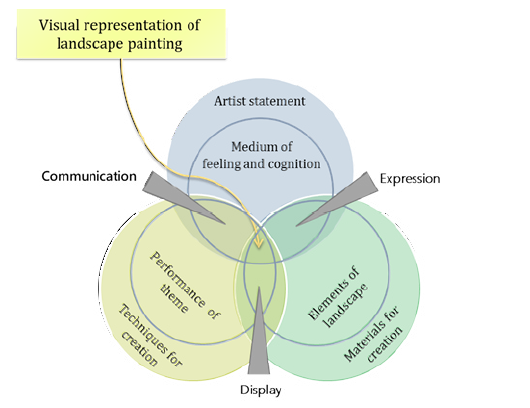
The form of visual presentation of landscape painting is affected by sensory media, expression elements, and landscape elements. Sensory media include cognition, sensation, and emotion; expression elements include themes, space, composition, and atmosphere; landscape elements include mountains, rocks, buildings, sky, clouds, flowers, grass, and trees [7]. The final visual presentation of landscape painting is not only the effect of these three factors but also the mutual application of artists’ creation ideas, creation materials, and creation techniques.
Painting creation started with landscape observation and picture thinking and to painting until the completion of the work. From picture thinking, the composition method, size, and materials of the work were applied to the further processing of the surface base on the canvas. Upon completion of the base, the painting was started and then corrected until the completion of the work. The two landscape paintings, Long Lines and Short Lines: Conflicts Has Always Been There and Landscape of a Landscape, which were converted into designs, used multiple media and the paper stacking technique and employed paper as the primary base. Since the King Wo paper is thin, the mounting technique was used to stack it up and make it thicker. The acrylic base agent was used for paper base processing to create textures, and acrylic base agents were repeatedly used to create rough textures so that pencils, pastels, and acrylic pigments could be used more smoothly.
Design structure
Design may be inspired by anything, and the process of observation and investigation will automatically affect the ideas of fashion design [29,30]. Recombination is the most common technique to convert inspirations into designs, and the idea of cross-border cooperation and conversion between art and design can create more new opportunities. Designers can add elements or ideas from inspiration sources to design with different strategies.
This study extended the five levels of creative hermeneutics in converting painting to design, namely actual meaning, intended meaning, implied meaning, deeper meaning, and creative meaning (Table 2), to faithful presentation, analysis and organization, different interpretations, new insights, and creative breakthroughs. Landscape paintings were converted into fashion design, moving landscapes, and eventually landscape clothing with actual landscapes, landscape analysis, and landscape interpretation.
Table 2:Description of design conversion at different levels of creative hermeneutics.

The process of applying paintings to fabric and clothing design was divided into two stages. In the first stage, elements were selected and interpreted, and the original work was copied through mirroring, line connecting, or partial line extracting and recomposed into a 90cm×110cm pattern for fabric output. In the second stagethe recombination and application process-fabrics were stacked, folded, and processed into graphic painting vocabularies for conversion to present the quality of graphic painting on fabrics so that they became the visual focus of clothing. Artistic creation and design generate creations or design ideas through observing and studying the topic. The ideas are special through unique design interpretations.
Work analysis
The Wearing Landscape Exhibition was held at Miaobei Art Center from March 21 to April 8, 2018. Fifteen paintings and six sets of fashion design works were put out for display, and two graphic paintings were made into fashion design works following the five levels of creative hermeneutics, as detailed below:
Actual meaning: Actual landscape: Scenes researchers see every day include houses on hills, telephone poles, and electric cables, and conflicts between the man-made environment and the natural environment Figure 2.
Figure 2:Scenes researchers see every day include houses on hills, telephone poles, and electric cables, and conflicts between the man-made environment and the natural environment.
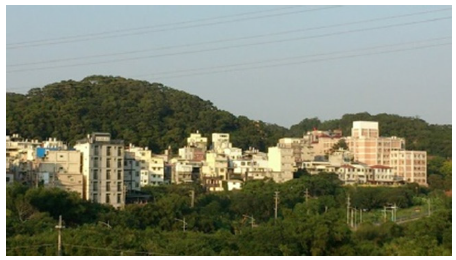
Intended meaning: Landscape analysis: To show the conflicts between man-made environment and natural environment. The natural elements selected from the scene’s researchers see every day are mountains and trees (Figure 3); the man-made factor is the electric cable (Figure 4).
Figure 3:To show the conflicts between man-made environment and natural environment. The natural elements selected from the scene’s researchers see every day are mountains and trees.
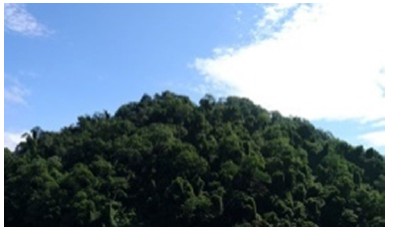
Figure 4:The man-made factor is the electric cable.
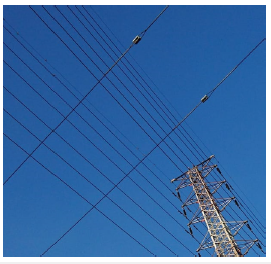
Implied meaning: Landscape interpretation: Selected elements were used for painting to show the conflicts between the man-made and the natural environment. While Long Lines and Short Lines: Conflicts Has Always Been There (Figure 5) is an aerial view, the scattered cables look like cracks that cut the earth, contrasting the long lines representing electric cables with the short lines representing forest and trees.
Figure 5:Long Lines and Short Lines: Conflicts Has Always Been There pencil, gesso, paper 38×26cm,2017.

Landscape of A Landscape (Figure 6) depicts the telephone poles standing on mountains and electric wires across mountains from a horizontal angle. The colors of mountains and forest were removed and placed in the sky, meanwhile, they were contrasted by crossing electric cables.
Figure 6:Landscape of A Landscape pencil, acrylic paint, paper 38×26cm, 2017.

Deeper meaning: moving landscape (recombined): Two works were converted into print fabrics, and paintings were made into three fabrics. In Long Lines and Short Lines: Conflicts Has Always Been There, sharp lines representing electric cables were taken as the main visual image. A style (Figure 7) was designed by connecting the lines, and the lattice B style (Figure 8) was formed by combining the vertical and horizontal lines in the picture extracted from the same work.
Figure 7:A-style was designed by connecting the lines.
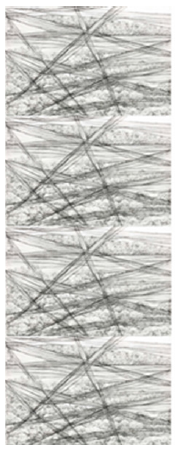
Figure 8:The lattice B-style was formed by combining the vertical and horizontal lines.
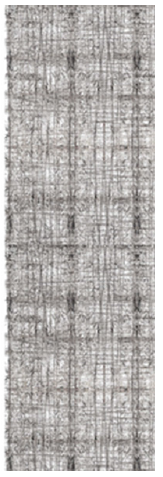
In Landscape of A Landscape, C style (Figure 9) was designed with continuous patterns mirroring the upper and lower parts in blue and white in the picture, and the colors of blue and white were applied to the fabric in large areas for fashion design.
Figure 9:C-style was designed with continuous patterns mirroring the upper and lower parts in blue and white.

Creative meaning: Landscape clothing: Wind coat: Fabrics with Print A were used as the front and back parts of the wind coat; thick lines ran through the left and right sides of the back piece by hand sewing, echoing the electric cables in the original painting (Figure 10).
Figure 10:Wind coat: Fabrics with Print A were used as the front and back parts of the wind coat; thick lines ran through the left and right sides of the back piece by hand sewing, echoing the electric cables in the original painting.
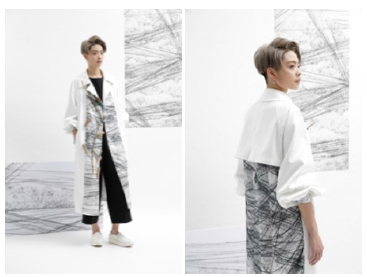
Skirt: A style and B style fabric were used, and the skirt was a straight type. Print fabrics were used to cover thick cotton strips on the skirt to generate obvious straight lines, and A style fabric was used on the right side of the skirt for the visual impression of overlapping waves, which contrasted with the straight lines formed by B style to reflect the conflict of man-made lines (Figure 11).
Figure 11:Skirt: A style and B style fabric were used, and the skirt was a straight type.

Top and trousers: B style fabric was used here. The top was made of space cotton to form a curved but rigid outline to reflect man-made objects in life. Print fabrics overlapping on the chest created a landscape that quickly fades as it moves (Figure 12).
Figure 12:Top and trousers: B style fabric was used here.

Top and skirt: The parts with a strong sense of lines and confusing colors in the print fabrics of the two paintings were used for the design to express people’s dark side of damaged landscapes. Electric cables in the picture became the lines on the clothing enwinding the human body (Figure 13).
Figure 13:Top and skirt: The parts with a strong sense of lines and confusing colors in the print fabrics of the two paintings were used for the design to express people’s dark side of damaged landscapes.

Top: Parts with contrasting colors in Landscape of A Landscape were used for asymmetric design, and hand-sewn embroidery was used at fabric joints to increase stereo perception (Figure 14)
Figure 14:Top: Parts with contrasting colors in Landscape of A Landscape were used for asymmetric design, and hand-sewn embroidery was used at fabric joints to increase stereo perception.
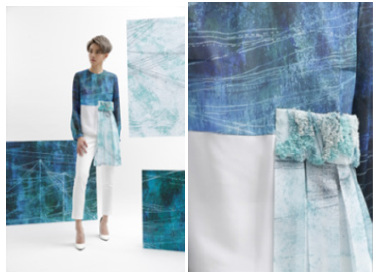
Suit: the final design of the collection echoing Landscape of a Landscape. Print fabrics were overlapped on the sleeves to echo the mountains and the sky in the picture, and hand-sewn white lines ran through the suit to represent the electric cables crossing mountains (Figure 15).
Figure 15:Suit: the final design of the collection echoing Landscape of A Landscape.
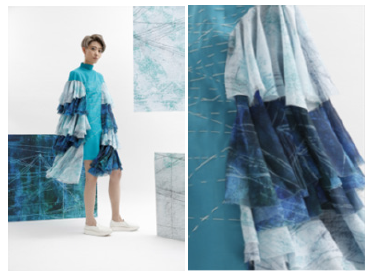
Two graphic paintings were made into three print fabrics and eventually made into six sets of ready-to-wear clothing. The conflicts between the man-made and the natural environment were reconsidered from the perspectives of landscapes in daily life to interpret researchers’ doubts on questions about landscapes. The sense of lines in the picture converted to print fabric echoed the hand-sewn lines on clothing, thus forming a contrast between painting and clothing.
Conclusion
Design points out that art and technology jointly produce new
cultural forms, and design plays a critical role in the vitality of art.
With art having to be more pragmatic and go beyond its intrinsic
limitations, design is certainly one of its most suitable cross-border
partners. The Wearing Landscape Exhibition applies the five levels
of creative hermeneutics-from painting to fashion design-and
analyzes and interprets the creation or design method at each level
to establish the conversion architecture of creative hermeneutics.
As a creation process growing out of nothing, artistic creation has
inspired countless fashion designers, with colors, patterns, and
printing of fabrics being the key parts of fashion design. Therefore,
by converting painting into fashion design, artistic elements
are integrated, making clothing a medium that conveys art. The
conclusions of the creation process from painting to fashion design
are as follows.
1) With landscapes as the topic, new thoughts on landscapes are
conveyed through actual landscape observation and landscape
reflection, becoming the painting theme and allowing creators
to reconsider the relationship between nature and man-made
objects concerning their questions on landscapes.
2) Making paintings into print fabrics is a process of reinterpreting
landscape and the key design conversion process, converting
paintings into print fabrics applicable to clothing through
recombination and abstraction.
3) Fashion design follows the model and the outlines of readyto-
wear clothing through local hand sewing to increase stereo
perception and echo the quality of graphic painting, turning
clothing into a real “walking art”.
In this study, researchers used two graphic paintings for print fabric design and fashion design to comprehensively apply the landscape concept from art creation to fashion design and better incorporate artistic concepts in fashion design. The creation results can be used as a reference for future practitioners in relevant fields for conversions between art and design.
References
- Hsieh MH, Guan SS (2011) Applying “Associative Forced Relationship of Formative Elements” in artistic commodities design. Journal of Design 16(4): 57-73.
- Henrik H, Vanessa MP (2008) Art infusion: the influence of visual art on the perception and evaluation of consumer products. Journal of Marketing Research 45: 379-389.
- Coles A (2005) On art’s romance with design. Design Issues 21(3): 17-24.
- Langer SK (1953) Feeling and form. Scribner's, New York, USA.
- Yang YY (2008) The formation of the idea of 'Local Color' in kin'ichirō ishikawa's landscape paintings of Taiwanese Scenery. Journal of Art Studies 3: 73-119.
- Lo HC (2016) Places: Becoming artistic fields. Journal of Taipei Fine Arts Museum 32: 65-94.
- Liao HT (2013) Observation of western landscape painting. In: Clark K (Ed.), Landscape into Art, Artco Books, Taipei, Taiwan.
- Mitchell WJT (1994) Landscape and Power, University of Chicago Press, Chicago, USA.
- Czepczynski M (2008) Cultural landscapes of post-socialist cities: Representation of powers and needs, Ashgate Publishing Limited, Farnham, UK.
- Berger J (1972) Ways of seeing. Penguin Books, UK.
- Clark K (1976) Landscape into Art. Harper & Row Publishers, NY, USA.
- Ogawa T (1986) Discussion on Chinese poem. Chinese University Press, Hong Kong, China.
- Chan WY (2002) The Sign of Jing 景 in Modern Chinese Poetry: Experience, memory, time and space. Journal of National Taiwan Normal University 47(2): 105-120.
- Su MT (2015) Landscape as ways of seeing. 35: 98-105.
- Tuan YF (2001) Space and place: The perspective of experience. University of Minnesota Press, Minneapolis, Minnesota, USA.
- Lee WC (2020) Exploring memory landscape with the perspective of human geography-with the artists' Works of Taipei's North Gate as an example. Journal of Design Science 23(1): 42-60.
- Fu WH (1990) Creative Hermeneutics Study and its application. In: From Creative Hermeneutics Study to Mahayana Buddhism. San Min Book Co Ltd., Taipei, Taiwan.
- Yeh ML (2019) Applying the historical interpretation in curation practices. Journal of Design Science 22(2): 73-92.
- Yung MH (1998) An essential element of creation-contempoeary poetry. Tonsan books, Taipei, Taiwan.
- Flusser V (1999) Shape of things: A philosophy of design. Reaktion, London, UK.
- Yen HY, Lin PH, Lin RT (2014) Qualia characteristics of cultural and creative products. Journal of Kansei 22(1): 34-61.
- You ML, Yeh PH, Kao YC (1996) A study on product image and its representation design with radio design as a case study. Journal of Design 2(1): 31-45.
- Petre M, Sharp H, Johnson J (2006) Complexity through combination: An account of knitwear design. Design Studies 27(2): 183-222.
- Lin H, Lin R, Hsieh H (2005) Exploring the possibilities of transforming Chinese characters into product design. Journal of Design 10(2): 77-87.
- Cao JX (2011) The creating of the mood of literary works in fashion design. Melliand, China, 7: 59-60.
- Yeh LC (2006) Clothing aesthetics. Shinning Culture, Taipei, Taiwan.
- Yen HY, Lin PH, Lin RT (2014) Qualia characteristics of cultural and creative products. Journal of Kansei 22(1): 34-61.
- Ma JP, Huang N (2017) The characters, meaning and context of ceramics re-creation in art and design. Journal of Design 22(1): 1-24.
- Frings GS (2007) Fashion: From concept to consumer. (9th edn), Pearson, New Jersey, USA.
- Tatham C, Seaman J (2003) Fashion design drawing course. Barrons, New York, USA.
- Kandinsky W (1977) Concerning the spiritual in art. Dover Publications, Inc., New York, USA.
© 2022 Rungtai Lin. This is an open access article distributed under the terms of the Creative Commons Attribution License , which permits unrestricted use, distribution, and build upon your work non-commercially.
 a Creative Commons Attribution 4.0 International License. Based on a work at www.crimsonpublishers.com.
Best viewed in
a Creative Commons Attribution 4.0 International License. Based on a work at www.crimsonpublishers.com.
Best viewed in 







.jpg)






























 Editorial Board Registrations
Editorial Board Registrations Submit your Article
Submit your Article Refer a Friend
Refer a Friend Advertise With Us
Advertise With Us
.jpg)






.jpg)














.bmp)
.jpg)
.png)
.jpg)










.jpg)






.png)

.png)



.png)






